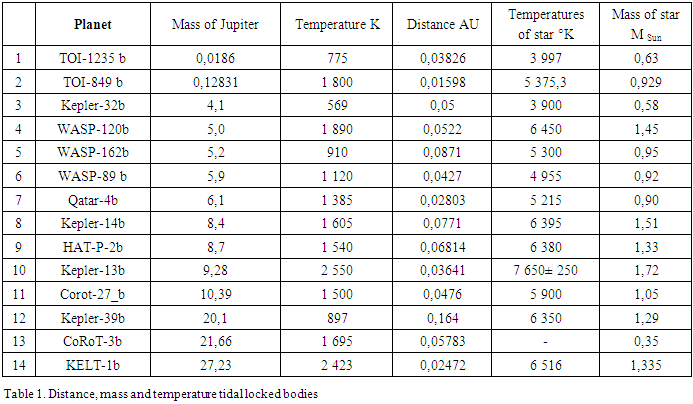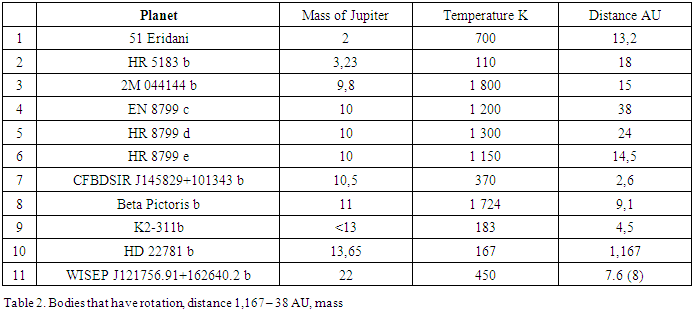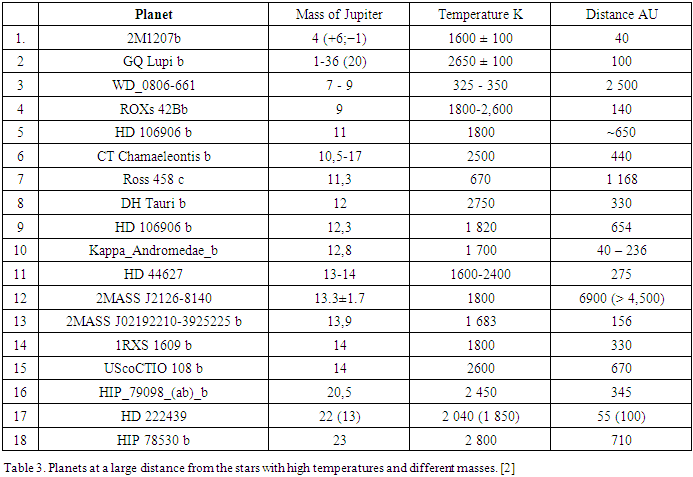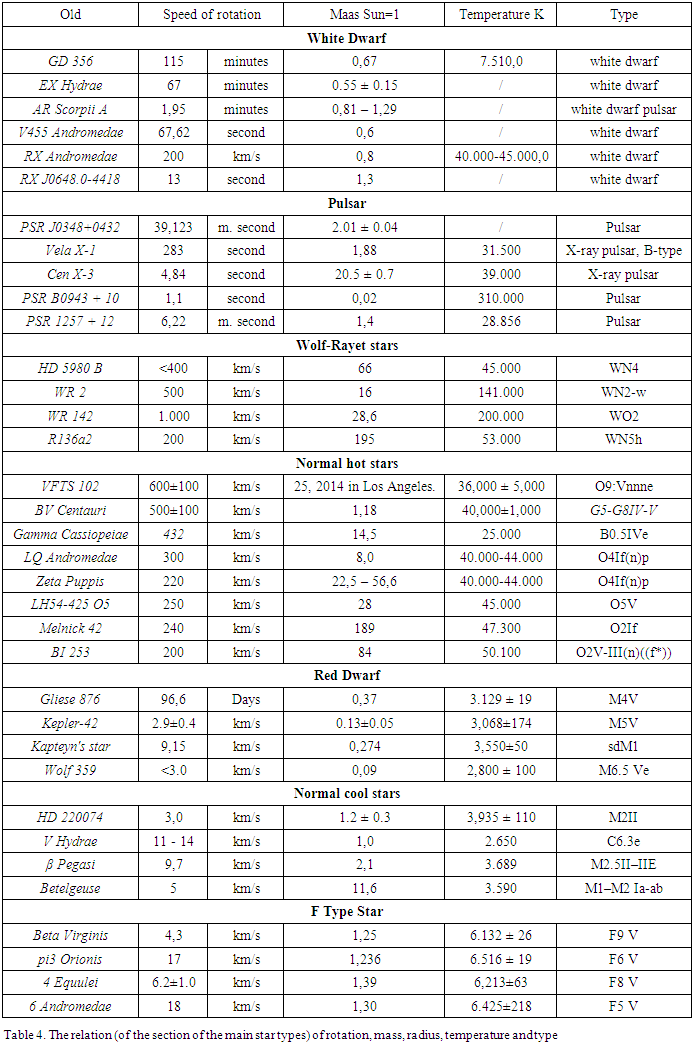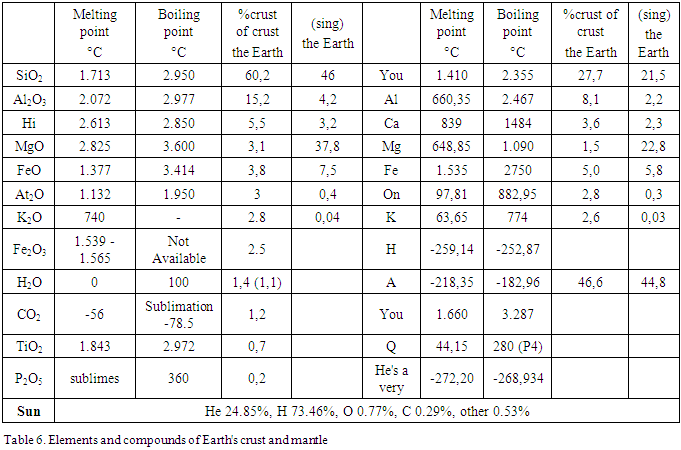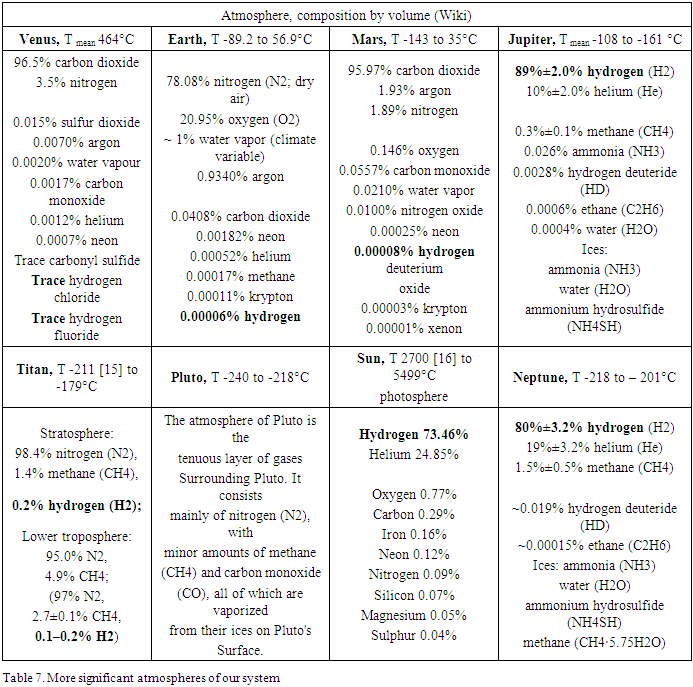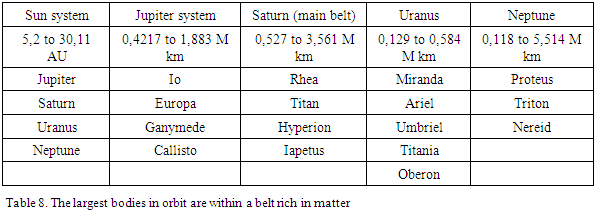-
Paper Information
- Paper Submission
-
Journal Information
- About This Journal
- Editorial Board
- Current Issue
- Archive
- Author Guidelines
- Contact Us
International Journal of Astronomy
p-ISSN: 2169-8848 e-ISSN: 2169-8856
2020; 9(1): 3-11
doi:10.5923/j.astronomy.20200901.02

The Processes that Determine the Formation and Chemical Composition of the Atmosphere of the Body in Orbit
Weitter Duckss
Independent Researcher, Zadar, Croatia
Correspondence to: Weitter Duckss, Independent Researcher, Zadar, Croatia.
| Email: |  |
Copyright © 2020 The Author(s). Published by Scientific & Academic Publishing.
This work is licensed under the Creative Commons Attribution International License (CC BY).
http://creativecommons.org/licenses/by/4.0/

The goal of this article is to analyze the formation of an atmosphere on the orbiting planets and to determine the processes that participate in the formation of an atmospheric chemical composition, as well as in determining it. The research primarily analyzes the formation of atmospheres on the objects of different sizes (masses) and at the same or different orbital distances. This paper analyzes the influence of a star's temperature, the space and the orbit's distance to an object's temperature level, as well as the influence of the operating temperature of atoms and chemical compounds to chemical composition and the representation of elements and compounds in an atmosphere. The objects, which possess different masses and temperatures, are able to create and do create different compositions and sizes of atmospheres in the same or different distances from their main objects (Saturn/Titan or Pluto). The processes that are included in the formation of an atmosphere are the following: operating temperatures of compounds and atoms, migrations of hydrogen, helium and the other elements and compounds towards a superior mass. The lack of oxygen and hydrogen is additionally related to the level of temperature of space, which can be classified into internal (characterized by the lack of hydrogen) and the others (characterized by the lack of oxygen).
Keywords: Atmosphere, Chemical composition of the atmosphere, Migration of the atmosphere
Cite this paper: Weitter Duckss, The Processes that Determine the Formation and Chemical Composition of the Atmosphere of the Body in Orbit, International Journal of Astronomy, Vol. 9 No. 1, 2020, pp. 3-11. doi: 10.5923/j.astronomy.20200901.02.
Article Outline
1. Introduction
- The article is based on existing evidence (measurements) for bodies (planets and other bodies) orbiting the Sun, as well as exoplanets. Proper handling of evidence refers to processes that lead to the detection of clear reasons why atmospheres can be made of nitrogen, hydrogen, CO2, CH4 and different quantities of other atoms and compounds from body to body. In addition to the star's influence on the atmosphere, other equally important processes are included: migration of atoms and compounds, rotation and tidal locked bodies, space and body temperature, processes that create high body temperatures, degradation of atoms and compounds not only due to the influence of the star. Here, atoms and compounds are observed through their operating temperatures and show why there are or are no specific atoms and compounds in the atmosphere. There is also evidence as to why we are reading atoms and compounds in the atmosphere even though they are not in a gaseous state at body temperature.Matter is presented in eight tables. These tables represent the relations with some values that cannot be ignored in the analysis of the processes that lead to the creation or the lack of an atmosphere on an object. All of the objects in the first table are tidally locked and are distanced from 0,016 to 0,16 AU. In the second and third tables there are objects with an independent rotation. The distances of the objects in the second table are from 1,167 to 18 AU and in the third table from 40 to 6 900 AU. Table 4 presents the influence of the speed of rotation to the temperature of an object, which significantly influences on the chemical composition of an atmosphere. Operating temperatures of atoms and compounds are given in Table 5. The existence of such measurements, which point out that there in an atmosphere are atoms and compounds that are in solid state or they disintegrate (at the object's temperature), is related to other, non-atmospheric processes. Table 6 introduces the evidence of complex matter being disintegrated in a natural process. The relation of the lack of atoms and compounds to the decrease of temperature is given in Table 7. The final, eighth table, presents the existence of regions of concentrated matter on every object and star.
2. Processes Responsible for the Existence of the Atmosphere and Its Chemical Composition
- Observing the existence and chemical composition of the atmosphere will be based on proving the processes that create the atmosphere and determine its chemical composition, based on evidence within our system and exoplanets.A method of confirmation: Gathering the measurements of mass, temperature, distance (for the orbiting objects) and the mass and temperature of a main star. Determining, if there are regularities in the same or different orbits for the same or different quantities of mass and providing a relevant overview.The level of temperature is related to the distance from a main star and to a rotation by using the rotation of stars. Creating an overview of elements and compounds that are suggested to exist in the atmosphere of an object and determining their abilities to create an atmosphere at different temperatures. Analyzing the complexity of an object's composition due to the exposure to high temperatures and, above all, pointing out the importance of temperatures above 1 000°C on a particular distant object as well as in general.Analyzing the development of a chemical structure on objects with the increase of mass and the distance from its star.Proving the existence of a certain distance at which matter is concentrated on the objects of our system. Explaining via the merger of objects the existence of systems that are different to ours and that are created through close or distant binary processes.Relating the migration of atoms and compounds to different compositions of atmospheres, as well as the lack of oxygen on the objects in the colder parts of the outer space. The atmosphere of the body in orbit is determined by: body mass, independent rotation of the body, distance from the main star, temperature of the main star, binary effects. The processes of migration of hydrogen, helium (for the atmosphere of Earth it is estimated to be 3 kg/s and the one of helium is 50 g/s. (István Lagzi et al. 2013 [1]) and other elements and compounds determine whether a body will have an atmosphere and its chemical composition (W. Ducks 2017, 2018, 2019 [2]). The process is directly dependent on a body mass. All smaller bodies regardless of the distance from the main star in the atmosphere will have hydrogen and helium below 1% of the total atmosphere. The exception: very distant bodies that don't have larger planets nearby.In our system, Pluto is 10 AU from Neptune and does not retain hydrogen and helium in the atmosphere, but has an atmosphere mainly of nitrogen (and something CH4 and CO).Heavier elements migrate from the body in orbit if positioned near the main star or another central body.The migration of heavier elements and compounds in the internal orbits is in a direct relation to the distance and mass of the body and the star. Achieving a sufficient body mass size, which prevents these processes, depends on the size and speed of rotation of the main body, as well as the existence of an independent rotation of the body or distance required in this relationship to enable the body to rotate.Mercury has a thin exosphere (0.5 nPa, (0.005 picobars) (NASA, Dr. D. R. Williams 2018. [3]) - an indication that all elements produced by the planet that have arrived in the atmosphere from space in the form of comets and asteroids reside briefly above the surface of the body. The size of Mercury (R 2 439.7 km) is insufficient to retain the atmosphere, like Titan the moon does, which has R 2 574.73 km. Saturn, which takes on the role of the Sun, does not have an attraction force strong enough to remove Titan's atmosphere at a distance of 1 221 870 km, but it successfully removes free hydrogen and helium.The Sun removes the atmosphere from Mercury at a distance of 57,909,050 km.We find the migration processes of atoms and compounds in exoplanets HD 209458 b radius 1.35 RJup, 6 700 000 km (0.045 AU) (David Ehrenreich et al. 2008 [4]), HD 189733 b RJup 1,138 RJup, distance 0.03099 AU (4 636 000 ± 90 000 km). (A. Lecavelier et al. 2010 [5]), GJ 436b 4 327 REarth, 0.028 AU (D. Ehrenreich et al. 2015 [6]).The impacts of body mass are seen in Iapetus and Rhea moons, which are 1,468 and 1,527 km in diameter and do not create atmospheres, especially Iapetus, which is more distant (3 560 820 km). Rhea (distance: 527 108 km) has a weak migratory exosphere.Oxygen has a boiling point of -182.96°C, maximum temperatures on Rhea of -174°C favor the formation of an atmosphere of oxygen, but minimum temperatures of -220°C crystallize oxygen and remove it from the atmosphere to the surface. CO2 freezes at -56.6°C and cannot linger for long above the surface of the body with a temperature of -174 to -220°C. (NASA 2010 [7]).Here it is important to note that, in general, all outer planets have negligible amounts of oxygen in the atmospheres, which suggests that oxygen is not one of the more important elements in the chemical structure of more distant bodies, where space temperatures are as low as the intensity of waves from the main star. (W. Ducks 2019).The atmospheres are made of hydrogen and helium on planets with a higher mass, while on the other smaller bodies, due to the migration of these elements, a part of the body (Triton, Titan, Pluto - the largest small bodies) in the atmosphere retains N2 with a small amount of CH4, CO, which mainly crystallize and returns to the surface. Pluto and Triton are colder than Titan and have a more significant removal of N2 from the atmosphere than Titan, due to the existence of temperatures below the tip point N2 and have a less impressive atmosphere.Exoplanets at all distances can become stars with a fully melted body.Figure 1 shows the visual notion of the temperature height shown in tables 1, 2 and 3. A body that has a temperature of >1 500°K is melted just as the lava of the Kīlauea volcano, i.e., the body is a classical star that produces and emits its radiation from its processes.Figure 1. Hawaiian volcano
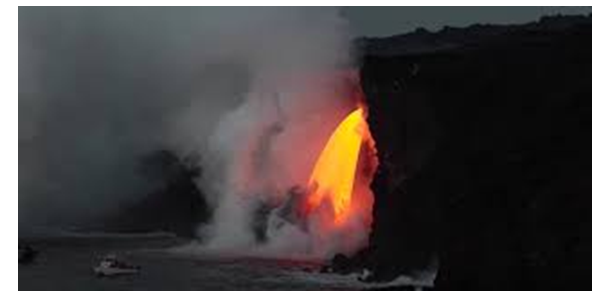 | Figure 1. Credit: The U.S. Geological Survey (USGS) |
|
|
|
|
|
|
|
|
3. Conclusions
- Observation of the atmosphere on bodies in orbit depends on the processes of migration of hydrogen, helium and other elements and compounds, which are in the gaseous state, towards the central body, body mass, distance from the central body, whether in inner or outer orbit, the action of binary effects, the rotation of the body in an orbit, the position of the body in and out of the gas and dust concentration zone, whether the bodies formed around a central body or merged into a system.The atmosphere is different with the internal from distant orbits. In the atmosphere, there are also non-gaseous particles of elements and compounds that got there through geological processes or the impact of other smaller bodies that arrived from space.The size of the body and space temperature determines which elements are in the gaseous state and how much of this material is present on the body.All these processes depend on the mass and the speed of rotation of the central body.
 Abstract
Abstract Reference
Reference Full-Text PDF
Full-Text PDF Full-text HTML
Full-text HTML